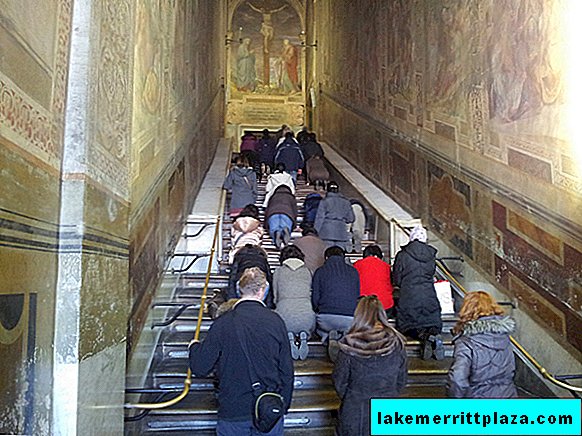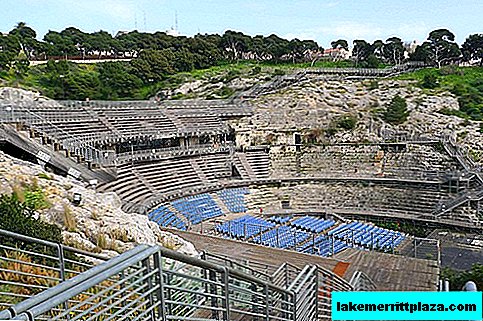The Holy Staircase (Latin: Scala Santa) is one of the most valuable relics of the Christian faith, located in Rome. 28 marble steps lead to the Holy of Holies (lat. Sancta Sanctorum) - the chapel of the popes, located in the Lateran Palace (Palazzo del Laterano).
Old legends say that it was on this staircase that the prosecutor Pontius Pilate escorted Jesus Christ to the court. Today pilgrims from all over the world climb the stairs.
Story

According to the scriptures, Pilate ruled the trial of Jesus in his possession (praetorium) in Jerusalem. The son of God, condemned to death, stepped along the wide marble steps. Pontiff Sergius II in his writings notes that in the 4th century AD, thanks to Julia Elena Augusta (lat. Iulia Helena), the mother of Emperor Constantine I, the relic was in Rome. Bishop Sylvester I, received a gift from the Queen and ordered to establish a shrine in the papal palace.
At the end of the 16th century, the Lateran Palace was significantly reconstructed. The holy staircase has found its current location. At the same time, it is believed that another 4 were added to the initial 24 steps. Construction work was carried out in a short time, the workers did not dare to desecrate the shrine with their own feet. The staircase was re-laid from top to bottom.
Towards the end of the 19th century, worship of the Holy Stairs or the Pilate Stairs (Latin Scala Pilati) reached its climax. Numerous pilgrims flocked to the Lateran Palace on the eve of major church holidays. In order to kneel down the path from the foot of the stairs to the Lavrentievsky chapel (Cappella di San Lorenzo in Palatio), reading the proper prayers at every step. In the end, the marble had to be hidden under wooden canvases in order to avoid their complete destruction.
Great trepidation in the souls of believers is caused by the traces of the blood of the Savior, which rolled down with his tormented back lashes, during the procession to Calvary. Slots in the shape of a cross on protective wooden panels allow you to fall to the most valuable relics of the Holy Stairs. Now the staircase has received special observation windows, which are mounted in the 2nd, 11th and 28th steps.
Architecture

The special atmosphere of the path leading to Santa Sanctorum is created by the frescoes of the medieval artist Baldassare Croce. The central place is occupied by a picture depicting the crucified Christ, the Mother of God and St. John. The remaining illustrations for Holy Scripture emphasize the great importance of the Lateran Palace and the Holy Stairs. In 2007, the restoration of the staircase was carried out, and Croce's work regained the lost colors and expressiveness.

Near the first step of the Holy Staircase there are two white marble statues. One of them is Judas Kiss by Alberto Giacometti, and the second is Pilate's Court by the same sculptor. Giacometti lived and worked throughout the 20th century; his works date back to (1901-1966).
- I advise you to read about: Vatican city-state
Interesting Facts
It is believed that pilgrims who ascended the Holy Steps during the celebration of Lent (every Friday) gain indulgence. On all other days, visitors receive partial absolution if they walk on their knees with all their feet, with an open and humble heart.
Being on the ancient steps, Catholics offer "Prayers when climbing the Holy Ladder", and Orthodox - Akathist to the Passion of Christ.

There are side steps along which you can get into the Holy of Holies, bypassing a series of kneeling worshipers.
In the Lavrentievsky chapel or St. Sanctorum, where the steps lead, the treasures of the Roman pontiffs are kept. And the most valuable treasure of the chapel is the miraculous icon with the face of the Savior - Akeropit (6th century AD).
Where is it, how to get, work time

- Address: Piazza San Giovanni in Laterano, 14
- Holy staircase located in a palace next to the Lateran Basilica or the Cathedral of San Giovanni in Laterano (Basilica di San Giovanni in Laterano). You can get there by metro (San Giovanni station), as well as buses No. 116, 81, 85, 87, 810 and 16.
- Opening hours: from 6:00 to 13:00, on holidays - from 7:00 to 12:30, and then from 15:00 to 18:30 (in the summer until 19:00).
- Services are sent to the Holy of Holies chapel at 6:30, 7:00, 9:00 and 17:30.
- Ticket price for Sanctum Sanctorum - 3.5 euros. Opening hours: from 9:30 to 12:40 and from 15:00 to 17:10, there is the opportunity to rent an audio guide.
- Praying on the steps of Scala Santa is completely free.. A prayer book written in one of 8 languages costs 2 euros.
- Telephone for inquiries and reservations:(+39) 329 75 11 111
- Official site: www.scala-santa.com








